Submarine Stratigraphy of the Eastern Bay of Naples: New Seismo-Stratigraphic Data and Implications for the Somma-Vesuvius and Campi Flegrei Volcanic Activity
Abstract
:1. Introduction
2. Datasets and Methods
3. Geological Setting
- (i)
- 22,000 yr cal BP “Pomici di Base”;
- (ii)
- 8900 yr cal BP “Mercato Pumice”;
- (iii)
- 4300 yr cal BP “Avellino Pumice”; and
- (iv)
- A.D. 79 “Pompeii Pumice”.
- (i)
- B-M inter-Plinian, between “Pomici di Base” and “Mercato Pumice”;
- (ii)
- M-A inter-Plinian, between “Mercato Pumice” and “Avellino Pumice”;
- (iii)
- A-P inter-Plinian, between “Avellino Pumice” and “Pompeii Pumice”; and
- (iv)
4. Results
4.1. Description of the Seismic Units
4.2. Geological Interpretation of the Seismic Units
5. Discussion and Conclusions
Funding
Institutional Review Board Statement
Informed Consent Statement
Conflicts of Interest
References
- Milia, A.; Mirabile, L.; Torrente, M.M.; Dvorak, J.J. Volcanism offshore of Vesuvius volcano in Naples Bay. Bull. Volcanol. 1998, 59, 404–413. [Google Scholar] [CrossRef]
- Bruno, P.P.G.; Rapolla, A. Study of sub-surface structure of Somma-Vesuvius (Italy) by seismic reflection data: Implications for Campanian volcanism. Tectonophysics 1999, 372, 193–213. [Google Scholar] [CrossRef]
- Milia, A.; Torrente, M.M.; Bellucci, F. A possible link between faulting, cryptodomes and lateral collapses at Vesuvius Volcano (Italy). Glob. Planet. Change 2012, 90–91, 121–134. [Google Scholar] [CrossRef]
- Sacchi, M.; Insinga, D.D.; Milia, A.; Molisso, F.; Raspini, A.; Torrente, M.M.; Conforti, A. Stratigraphic signature of the Vesuvius 79 AD event off the Sarno prodelta system, Naples Bay. Mar. Geol. 2005, 222–223, 443–469. [Google Scholar] [CrossRef]
- Aiello, G.; Angelino, A.; D’Argenio, B.; Marsella, E.; Pelosi, N.; Ruggieri, S.; Siniscalchi, A. Buried volcanic structures in the Gulf of Naples (Southern Tyrrhenian sea, Italy) resulting from high resolution magnetic survey and seismic profiling. Ann. Geophys. 2005, 48, 1–15. [Google Scholar]
- Passaro, S.; Sacchi, M.; Tamburrino, S.; Ventura, G. Fluid Vents, Flank Instability, and Seafloor Processes along the Submarine Slopes of the Somma-Vesuvius Volcano, Eastern Tyrrhenian Margin. Geosciences 2018, 8, 60. [Google Scholar] [CrossRef] [Green Version]
- Milia, A.; Torrente, M.M. Space-time evolution of an active volcanic field in an extensional region: The example of the Campania margin (eastern Tyrrhenian Sea). In Vesuvius, Campi Flegrei, and Campanian Volcanism, 1st ed.; De Vivo, B., Belkin, H., Rolandi, G., Eds.; Elsevier: New York, NY, USA, 2020; pp. 297–321. [Google Scholar]
- Rosi, M.; Sbrana, A. Phlegrean Fields; Consiglio Nazionale delle Ricerche, Quaderni de La Ricerca Scientifica: Rome, Italy, 1987. [Google Scholar]
- Scandone, R.; Bellucci, F.; Lirer, L.; Rolandi, G. The structure of the Campanian Plain and the activity of the Neapolitan volcanoes (Italy). J. Volcanol. Geoth. Res. 1991, 48, 1–31. [Google Scholar] [CrossRef]
- Orsi, G.; De Vita, S.; Di Vito, M. The restless, resurgent Campi Flegrei nested caldera (Italy): Constraints on its evolution and configuration. J. Volcanol. Geoth. Res. 1996, 74, 179–214. [Google Scholar] [CrossRef]
- Di Vito, M.A.; Isaia, R.; Orsi, G.; Southon, J.; De Vita, S.; D’Antonio, M.; Pappalardo, L.; Piochi, M. Volcanism and deformation since 12,000 years at the Campi Flegrei caldera (Italy). J. Volcanol. Geoth. Res. 1999, 91, 221–246. [Google Scholar] [CrossRef]
- Aiello, G.; Marsella, E.; Di Fiore, V. New seismo-stratigraphic and marine magnetic data of the Gulf of Pozzuoli (Naples Bay, Tyrrhenian sea, Italy): Inferences for the tectonic and magmatic events of the Phlegrean Fields volcanic complex (Campania). Mar. Geophys. Res. 2012, 33, 93–125. [Google Scholar] [CrossRef] [Green Version]
- Fitzsimmons, K.E.; Hambach, U.; Veres, D.; Iovita, R. The Campanian Ignimbrite Eruption: New Data on Volcanic Ash Dispersal and Its Potential Impact on Human Evolution. PLoS ONE 2013, 8, e65839. [Google Scholar] [CrossRef] [PubMed]
- Aiello, G.; Giordano, L.; Giordano, F. High-resolution seismic stratigraphy of the Gulf of Pozzuoli (Naples Bay) and relationships with submarine volcanic setting of the Phlegrean Fields volcanic complex. Rend. Lincei Sci. Fis. E Nat. 2016, 27, 775–801. [Google Scholar] [CrossRef]
- Giaccio, B.; Hajdas, I.; Isaia, R.; Deino, A.; Nomade, S. High-precision 14C and 40Ar/39Ar dating of the Campanian Ignimbrite (Y-5) reconciles the time-scales of climatic-cultural processes at 40 ka. Sci. Rep. 2017, 7, 45940. [Google Scholar] [CrossRef] [PubMed] [Green Version]
- Scarpati, C.; Cole, P.; Perrotta, A. The Neapolitan Yellow Tuff: A large volume multiphase eruption from Campi Flegrei, Southern Italy. Bull. Volcanol. 1993, 55, 343–356. [Google Scholar] [CrossRef]
- Wohletz, K.; Orsi, G.; De Vita, S. Eruptive mechanism of the Neapolitan Yellow Tuff interpreted from stratigraphic, chemical and granulometric data. J. Volcanol. Geoth. Res. 1995, 67, 263–290. [Google Scholar] [CrossRef]
- Deino, A.L.; Orsi, G.; Piochi, M.; De Vita, S. The age of the Neapolitan Yellow Tuff caldera forming eruption (Campi Flegrei caldera—Italy) assessed by 40Ar/39Ar dating method. J. Volcanol. Geoth. Res. 2004, 133, 157–170. [Google Scholar] [CrossRef]
- Pabst, S.; Wörner, G.; Civetta, L.; Tesoro, R. Magma chamber evolution prior to the Campanian Ignimbrite and Neapolitan Yellow Tuff eruptions (Campi Flegrei, Italy). Bull. Volcanol. 2008, 70, 961–976. [Google Scholar] [CrossRef] [Green Version]
- Sacchi, M.; Pepe, F.; Corradino, M.; Insinga, D.D.; Molisso, F.; Lubritto, C. The Neapolitan Yellow Tuff caldera offshore the Campi Flegrei: Stratal architecture and kinematic reconstruction during the last 15 ky. Mar. Geol. 2014, 354, 15–33. [Google Scholar] [CrossRef] [Green Version]
- Aiello, G.; Insinga, D.D.; Iorio, M.; Meo, A.; Senatore, M.R. On the occurrence of the Neapolitan Yellow Tuff tephra in the Northern Phlegraean Fields offshore (Eastern Tyrrhenian margin; Italy). Ital. J. Geosci. 2017, 136, 263–274. [Google Scholar] [CrossRef]
- Gurioli, L.; Cioni, R.; Sbrana, A.; Zanella, E. Transport and deposition of pyroclastic density currents over an inhabited area: The deposits of the AD 79 eruption of Vesuvius at Herculaneum (Italy). Sedimentology 2002, 49, 929–953. [Google Scholar] [CrossRef]
- Cioni, R.; Gurioli, L.; Lanza, R.; Zanella, E. Temperatures of the A.D. 79 pyroclastic density current deposits (Vesuvius, Italy). J. Geophys. Res. 2004, 109, B02207. [Google Scholar] [CrossRef]
- Gurioli, L.; Zanella, E.; Pareschi, M.T.; Lanza, R. Influences of urban fabric on pyroclastic density currents at Pompeii (Italy) I: Flow direction and deposition. J. Geophys. Res. 2007, 112, B05213. [Google Scholar] [CrossRef]
- Gurioli, L.; Sulpizio, R.; Cioni, R.; Sbrana, A.; Santacroce, R.; Luperini, W.; Andronico, D. Pyroclastic flow hazard assessment at Somma-Vesuvius based on the geological record. Bull. Volcanol. 2010, 72, 1021–1038. [Google Scholar] [CrossRef]
- Shea, T.; Gurioli, L.; Houghton, B.F.; Cioni, R.; Cashman, K.V. Column collapse and generation of pyroclastic density currents during the A.D. 79 eruption of Vesuvius: The role of pyroclastic density. Geology 2011, 39, 695–698. [Google Scholar] [CrossRef] [Green Version]
- Cioni, R.; Tadini, A.; Gurioli, L.; Bertagnini, A.; Mulas, M.; Bevilacqua, A.; Neri, A. Estimating eruptive parameters and related uncertainties for pyroclastic density current deposits: Worked examples from Somma-Vesuvius (Italy). Bull. Volcanol. 2020, 82, 65. [Google Scholar] [CrossRef]
- Tadini, A.; Bevilacqua, A.; Neri, A.; Cioni, R.; Biagioli, G.; Vitturi, M.; Esposti Ongaro, T. Reproducing pyroclastic density current deposits of the 79 CE eruption of the Somma-Vesuvius volcano using the box-model approach. Solid Earth 2021, 12, 119–139. [Google Scholar] [CrossRef]
- Available online: http://www.isprambiente.gov.it/Media/carg/campania.html (accessed on 16 October 2022).
- Colorado School of Mines. Seismic Unix, Center for Wave Phenomena. 2000. Available online: https://wiki.seismic-unix.org/doku.php (accessed on 16 October 2022).
- Mitchum, R.M., Jr.; Vail, P.R.; Sangree, J.B. Stratigraphic interpretation of seismic reflection patterns in depositional sequences. In Seismic Stratigraphy—Applications to Hydrocarbon Exploration; Payton, C.E., Ed.; American Association of Petroleum Geologists: Tulsa, OH, USA, 1977; Volume 26, pp. 117–133. [Google Scholar]
- Vail, P.R.; Mitchum, R.M.; Thompson, S. Relative changes of sea level from coastal onlap. In Seismic Stratigraphy—Applications to Hydrocarbon Exploration; Payton, C E., Ed.; American Association of Petroleum Geologists: Tulsa, OH, USA, 1977; Volume 26, pp. 83–97. [Google Scholar]
- Vail, P.R.; Hardenbol, J.; Todd, R.G. Jurassic unconformities, chronostratigraphy and sea-level changes from seismic stratigraphy and biostratigraphy. In Interregional Unconformities and Hydrocarbon Accumulation; Schlee, J S., Ed.; American Association of Petroleum Geologists: Tulsa, OH, USA, 1984; Volume 36, pp. 129–144. [Google Scholar]
- Planke, S.P.A.; Symonds, E.; Avelstad, J.; Skogseid, J. Seismic volcano stratigraphy of large-volume basaltic extrusive complexes on rifted margins. J. Geophys Res 2000, 105, 19335–19351. [Google Scholar]
- Carlson, R.L.; Gangi, A.F.; Snow, K.L. Empirical reflection travel time versus depth and velocity versus depth functions for the deep sea sediments column. J. Geophys. Res. 1986, 91, 8249–8266. [Google Scholar] [CrossRef]
- Brocchini, F.; Principe, C.; Castradori, D.; Laurenzi, M.A.; Gorla, L. Quaternary evolution of the southern sector of the Campanian Plain and early Somma-Vesuvius activity: Insights from the Trecase well. Mineral. Petrol. 2001, 73, 67–91. [Google Scholar] [CrossRef]
- De Lorenzo, G. L’attività vulcanica dei Campi Flegrei. Rend. Acc. Sci. Fis. E Mat. Napoli 1904, 10, 203–221. [Google Scholar]
- Santacroce, R. Somma-Vesuvius; CNR, Quaderni De La Ricerca Scientifica: Rome, Italy, 1987. [Google Scholar]
- Ortolani, F.; Aprile, F. Nuovi dati sulla struttura profonda della Piana Campana a SE del Fiume Volturno. Boll. Soc. Geol. Ital. 1978, 97, 591–608. [Google Scholar]
- Aiello, G.; Cicchella, A.G.; Di Fiore, V.; Marsella, E. New seismo-stratigraphic data of the Volturno Basin (northern Campania, Tyrrhenian margin, southern Italy): Implications for tectono-stratigraphy of the Campania and Latium sedimentary basins. Ann. Geophys. 2011, 54, 265–283. [Google Scholar]
- Torrente, M.M.; Milia, A. Volcanism and faulting of the Campania margin (Eastern Tyrrhenian Sea, Italy): A three-dimensional visualization of a new volcanic field off Campi Flegrei. Bull. Volcanol. 2013, 75, 719. [Google Scholar] [CrossRef]
- Ippolito, F.; Ortolani, F.; Russo, M. Struttura marginale tirrenica dell’Appennino Campano: Reinterpretazione di dati di antiche ricerche di idrocarburi. Mem. Soc. Geol. Ital. 1973, 12, 227–250. [Google Scholar]
- Barberi, F.; Innocenti, F.; Lirer, L.; Munno, R.; Pescatore, T.; Santacroce, R. The Campanian Ignimbrite: A major prehistoric eruption in the Neapolitan area (Italy). Bull. Volcanol. 1978, 41, 10–31. [Google Scholar] [CrossRef]
- Fisher, R.V.; Orsi, G.; Ort, M.; Heiken, G. Mobility of a large-volume pyroclastic flow—emplacement of the Campanian ignimbrite, Italy. J. Volcanol. Geoth. Res. 1993, 56, 205–220. [Google Scholar] [CrossRef]
- Rosi, M.; Vezzoli, L.; Aleotti, P.; De Censi, M. Interaction between caldera collapse and eruptive dynamics during the Campanian Ignimbrite eruption, Phlegrean Fields, Italy. Bull. Volcanol. 1996, 57, 541–554. [Google Scholar] [CrossRef]
- Civetta, L.; Orsi, G.; Pappalardo, L.; Fisher, R.V.; Heiken, G.; Ort, M. Geochemical zoning, mingling, eruptive dynamics and depositional processes—The Campanian Ignimbrite, Campi Flegrei caldera, Italy. J. Volcanol. Geoth. Res. 1997, 75, 183–219. [Google Scholar] [CrossRef]
- Pappalardo, L.; Civetta, L.; D’Antonio, M.; Deino, A.; Di Vito, M.A.; Orsi, G.; Carandente, A.; De Vita, S.; Isaia, R.; Piochi, M. Chemical and Sr-isotopical evolution of the Phlegraean magmatic system before the Campanian Ignimbrite and the Neapolitan Yellow Tuff eruptions. J. Volcanol. Geoth. Res. 1999, 91, 141–166. [Google Scholar] [CrossRef]
- Marianelli, P.; Sbrana, A.; Proto, M. Magma chamber of the Campi Flegrei supervolcano at the time of eruption of the Campanian Ignimbrite. Geology 2006, 34, 937–940. [Google Scholar] [CrossRef]
- Fedele, F.G.; Giaccio, B.; Hajdas, I. Timescales and cultural process at 40,000 BP in the light of the Campanian Ignimbrite eruption, Western Eurasia. J. Hum. Evol. 2008, 55, 834–857. [Google Scholar] [CrossRef] [PubMed]
- Costa, A.; Folch, A.; Macedonio, G.; Giaccio, B.; Isaia, R.; Smith, V.C. Quantifying volcanic ash dispersal and impact of the Campanian Ignimbrite super-eruption. Geophys. Res. Lett. 2012, 39, L10310. [Google Scholar] [CrossRef] [Green Version]
- Marti, A.; Folch, A.; Costa, A.; Engwell, S. Recostructing the plinian and co-ignimbrite sources of large volcanic eruptions: A novel approach for the Campanian Ignimbrite. Sci. Rep. 2016, 6, 21220. [Google Scholar] [CrossRef] [PubMed] [Green Version]
- Rolandi, G.; Bellucci, F.; Heizler, M.T.; Belkin, H.E.; De Vivo, B. Tectonic controls on the genesis of ignimbrites from the Campanian Volcanic Zone, southern Italy. Mineral. Petrol. 2003, 79, 3–31. [Google Scholar] [CrossRef]
- Romano, P.; Santo, A.; Voltaggio, M. L’evoluzione geomorfologica della pianura del fiume Volturno (Campania) durante il tardo Quaternario (Pleistocene medio-superiore-Olocene). Il Quat. 1994, 7, 41–56. [Google Scholar]
- Martinson, D.; Pisias, N.; Hays, J.; Imbrie, J.; Moore, T.; Shackleton, N. Age Dating and the Orbital Theory of the Ice Ages: Development of a High-Resolution 0 to 300,000-Year Chronostratigraphy. Quat. Res. 1987, 27, 1–29. [Google Scholar] [CrossRef] [Green Version]
- De Vivo, B.; Rolandi, G.; Gans, P.B.; Calvert, A.; Bohrson, W.A.; Spera, F.J.; Belkin, H.E. New constraints on the pyroclastic eruptive history of the Campanian volcanic Plain (Italy). Mineral. Petrol. 2001, 73, 47–65. [Google Scholar] [CrossRef]
- Webster, J.D.; Raia, F.; Tappen, C.; De Vivo, B. Pre-eruptive geochemistry of the ignimbrite-forming magmas of the Campanian Volcanic Zone, Southern Italy, determined from silicate melt inclusions. Mineral. Petrol. 2003, 79, 99–125. [Google Scholar] [CrossRef]
- Bellucci, F.; Milia, A.; Rolandi, G.; Torrente, M.M. Structural control on the Upper Pleistocene ignimbrite eruptions in the Neapolitan area (Italy): Volcano-tectonic faults versus caldera faults. In Vesuvius, Campi Flegrei, and Campanian Volcanism, 1st ed.; De Vivo, B., Belkin, H., Rolandi, G., Eds.; Elsevier: New York, NY, USA, 2020; pp. 163–180. [Google Scholar]
- Zanchetta, G.; Sulpizio, R.; Giaccio, B.; Siani, G.; Paterne, M.; Wulf, S.; D’Orazio, M. The Y-3 tephra: A Last Glacial stratigraphic marker for the central Mediterranean basin. J. Volcanol. Geoth. Res. 2008, 177, 145–154. [Google Scholar] [CrossRef]
- Aiello, G.; Iorio, M.; Molisso, F.; Sacchi, M. Integrated Morpho-Bathymetric, Seismic-Stratigraphic, and Sedimentological Data on the Dohrn Canyon (Naples Bay, Southern Tyrrhenian Sea): Relationships with Volcanism and Tectonics. Geosciences 2020, 10, 319. [Google Scholar] [CrossRef]
- Rolandi, G.; De Natale, G.; Kilburn, C.R.J.; Troise, C.; Somma, R.; Di Lascio, M.; Fedele, A.; Rolandi, R. The 39 ka Campanian Ignimbrite eruption: New data on source area in the Campanian Plain. In Vesuvius, Campi Flegrei, and Campanian Volcanism, 1st ed.; De Vivo, B., Belkin, H., Rolandi, G., Eds.; Elsevier: New York, NY, USA, 2020; pp. 175–205. [Google Scholar]
- D’Argenio, B.; Pescatore, T.; Scandone, P. Schema geologico dell’Appennino meridionale (Campania e Lucania). In Proceedings of the Conference Moderne Vedute sulla Geologia dell’Appennino, Roma; Accademia Nazionale dei Lincei; Rome, Italy, 1973; pp. 1–183. [Google Scholar]
- Bigi, G.; Bonardi, G.; Catalano, R.; Cosentino, D.; Lentini, F.; Parotto, M.; Sartori, R.; Scandone, P.; Turco, E. Structural Model of Italy, 1:500.000; Progetto Finalizzato Geodinamica, Consiglio Nazionale delle Ricerche: Rome, Italy, 1992. [Google Scholar]
- Cinque, A.; Aucelli, P.P.C.; Brancaccio, L.; Mele, R.; Milia, A.; Robustelli, G.; Romano, P.; Russo, F.; Russo, M.; Santangelo, N.; et al. Volcanism, tectonics and recent geomorphological change in the Bay of Napoli. Suppl. Geogr. Fis. Dinam. Quat. 1997, 3, 123–141. [Google Scholar]
- Vitale, S.; Ciarcia, S. Tectono-stratigraphic setting of the Campania region (southern Italy). J. Maps 2018, 14, 9–21. [Google Scholar] [CrossRef]
- Perrotta, A.; Scarpati, C.; Luongo, G.; Morra, V. The Campi Flegrei caldera boundary in the city of Naples. In Vesuvius, Campi Flegrei, and Campanian Volcanism, 1st ed.; De Vivo, B., Belkin, H., Rolandi, G., Eds.; Elsevier: New York, NY, USA, 2020; pp. 85–96. [Google Scholar]
- Acocella, V.; Funiciello, R.; Marotta, E.; Orsi, G.; De Vita, S. The role of extensional structures on experimental calderas and resurgence. J. Volcanol. Geoth. Res. 2004, 129, 199–217. [Google Scholar] [CrossRef]
- Acocella, V. Activating and reactivating pairs of nested collapses during caldera forming eruptions: Campi Flegrei (Italy). Geophys. Res. Lett. 2008, 35, L17304. [Google Scholar] [CrossRef]
- Acocella, V. Evaluating fracture patterns within a resurgent caldera: Campi Flegrei, Italy. Bull. Volcanol. 2010, 72, 623–638. [Google Scholar] [CrossRef]
- Capuano, P.; Russo, G.; Civetta, L.; Orsi, G.; D’Antonio, M.; Moretti, R. The active portion of the Campi Flegrei caldera structure imaged by 3-D inversion of gravity data. Geochem. Geophys. Geosystems 2013, 14, 276. [Google Scholar] [CrossRef] [Green Version]
- Vitale, S.; Isaia, R. Fractures and faults in volcanic rocks (Campi Flegrei, southern Italy): Insight into volcano-tectonic processes. Int. J. Earth Sci. 2014, 103, 801–819. [Google Scholar] [CrossRef]
- Ascione, A.; Aucelli, P.P.C.; Cinque, A.; Di Paola, G.; Mattei, G.; Ruello, M.R.; Russo Ermolli, E.; Santangelo, N.; Valente, E. Geomorphology of Naples and the Campi Flegrei: Human and natural landscapes in a restless land. J. Maps 2021, 17, 18–28. [Google Scholar] [CrossRef]
- Mastrolorenzo, G. Averno tuff ring in Campi Flegrei (south Italy). Bull. Volcanol. 1994, 56, 561–572. [Google Scholar] [CrossRef]
- Santacroce, R.; Cioni, R.; Marianelli, P.; Sbrana, A.; Sulpizio, R.; Zanchetta, G.; Donahue, D.J.; Joron, J.L. Age and whole rock-glass compositions of proximal pyroclastics from the major explosive eruptions of Somma-Vesuvius. A review as a tool for distal tephrostratigraphy. J. Volcanol. Geoth. Res. 2008, 177, 1–18. [Google Scholar] [CrossRef]
- Cioni, R.; Bertagnini, A.; Santacroce, R.; Andronico, D. Explosive activity and eruption scenarios at Somma-Vesuvius (Italy). Towards a new classification scheme. J. Volcanol. Geoth. Res. 2009, 178, 331–346. [Google Scholar] [CrossRef]
- Sbrana, A.; Cioni, R.; Marianelli, P.; Sulpizio, R.; Andronico, D.; Pasquini, G. Volcanic Evolution of the Somma-Vesuvius Complex (Italy). J. Maps 2020, 16, 137–147. [Google Scholar] [CrossRef] [Green Version]
- Sacchi, M.; D’Argenio, B.; Morra, V.; Petrazzuoli, S.; Aiello, G.; Budillon, F.; Sarnacchiaro, G.; Tonielli, R. Pyroclastic lumps: Quick diapiric structures off the Naples Bay, Italy. In Proceedings of the European Geophysical Society (EGS), 25th General Assembly, Millenium Conference on Earth, Planetary & Solar Systems, Nice, France, 25–29 April 2000. [Google Scholar]
- Aiello, G.; Budillon, F.; Cristofalo, G.; D’Argenio, B.; De Alteriis, G.; De Lauro, M.; Ferraro, L.; Marsella, E.; Pelosi, N.; Sacchi, M.; et al. Marine geology and morpho-bathymetry in the Bay of Naples (South eastern Tyrrhenian sea, Italy). In Mediterranean Ecosystems: Structures and Processes; Faranda, F.M., Guglielmo, L., Spezie, G., Eds.; Springer: Milano, Italy, 2001; pp. 1–8. [Google Scholar]
- Steinmann, L.; Spiess, V.; Sacchi, M. The Campi Flegrei caldera (Italy): Formation and evolution in interplay with sea-level variations since the Campanian Ignimbrite eruption at 39 ka. J. Volcanol. Geoth. Res. 2016, 327, 361–374. [Google Scholar] [CrossRef]
- Steinmann, L.; Spiess, V.; Sacchi, M. Post-collapse evolution of a coastal caldera system: Insights from a 3-D multichannel seismic survey from the Campi Flegrei caldera (Italy). J. Volcanol. Geoth. Res. 2018, 349, 83–98. [Google Scholar] [CrossRef]
- Natale, J.; Ferranti, L.; Isaia, R.; Marino, C.; Sacchi, M.; Spiess, V.; Steinmann, L.; Vitale, S. Integrated on-land-offshore stratigraphy of the Campi Flegrei caldera: New insights into the volcano-tectonic evolution in the last 15 kyr. Basin Res. 2021, 34, 1–28. [Google Scholar] [CrossRef]
- Lowe, D.J. Tephrochronology and its application: A review. Quat. Geochronol. 2011, 6, 107–153. [Google Scholar] [CrossRef] [Green Version]
- Zanchetta, G.; Sulpizio, R.; Roberts, N.; Cioni, R.; Eastwood, W.J.; Siani, G.; Caron, B.; Paterne, M.; Santacroce, R. Tephrostratigraphy, chronology and climatic events of the Mediterranean basin during the Holocene: An overview. Holocene 2011, 21, 33–52. [Google Scholar] [CrossRef]
- Insinga, D.D.; Tamburrino, S.; Lirer, F.; Vezzoli, L.; Barra, M.; De Lange, G.J.; Tiepolo, M.; Vallefuoco, M.; Mazzola, S.; Sprovieri, M. Tephrochronology of the astronomically-tuned KC01B deep-sea core, Ionian Sea: Insights into the explosive activity of the Central Mediterranean area during the last 200 ka. Quat. Sci. Rev. 2014, 85, 63–84. [Google Scholar] [CrossRef]
- Buccheri, G.; Capretto, G.; Di Donato, V.; Esposito, P.; Ferruzza, G.; Pescatore, T.S.; Russo Ermolli, E.; Senatore, M.R.; Sprovieri, M.; Bertoldo, M.; et al. A high resolution record of the last deglaciation in the southern Tyrrhenian sea: Environmental and climatic evolution. Mar. Geol. 2002, 186, 447–470. [Google Scholar] [CrossRef]
- Iorio, M.; Sagnotti, L.; Angelino, A.; Budillon, F.; D’Argenio, B.; Dinares-Turell, J.; Macrì, P.; Marsella, E. High resolution petrophysical and palaeomagnetic study of Late Holocene shelf sediments, Salerno Gulf, Tyrrhenian Sea. Holocene 2004, 14, 425–426. [Google Scholar] [CrossRef]
- Insinga, D.D.; Molisso, F.; Lubritto, C.; Sacchi, M.; Passariello, L.; Morra, V. The proximal marine record of Somma-Vesuvius volcanic activity in the Naples and Salerno bays, Eastern Tyrrhenian sea, during the last 3 kyrs. J. Volcanol. Geoth. Res. 2008, 177, 170–186. [Google Scholar] [CrossRef]
- Lirer, F.; Sprovieri, M.; Ferraro, L.; Vallefuoco, M.; Capotondi, L.; Cascella, A.; Petrosino, P.; Insinga, D.D.; Pelosi, N.; Tamburrino, S.; et al. Integrated stratigraphy in the eastern Tyrrhenian sea. Quat. Int. 2013, 292, 71–85. [Google Scholar] [CrossRef]
- Margaritelli, G.; Vallefuoco, M.; Di Rita, F.; Capotondi, L.; Bellucci, L.G.; Insinga, D.D.; Petrosino, P.; Bonomo, S.; Cacho, I.; Cascella, A.; et al. Marine response to climate changes during the last five millennia in the central Mediterranean Sea. Glob. Planet. Change 2016, 142, 53–72. [Google Scholar] [CrossRef]
- Sulpizio, R.; Cioni, R.; Di Vito, M.A.; Santacroce, R.; Sbrana, A.; Zanchetta, G. Comment on: ‘‘The dark nature of Somma-Vesuvius volcano: Evidence from the 3.5 ka B P Avellino eruption’’ by Milia, A., Raspini, A., Torrente, M.M. Quat. Int. 2008, 192, 102–109. [Google Scholar] [CrossRef] [Green Version]
- Milia, A.; Raspini, A.; Torrente, M.M. The dark nature of Somma-Vesuvius volcano: Evidence from the 3.5 ka B.P. Avellino eruption. Quat. Int. 2007, 173–174, 57–66. [Google Scholar] [CrossRef]
- De Vivo, B.; Belkin, H.E.; Rolandi, G. Introduction to Vesuvius, Campi Flegrei, and Campanian Volcanism, In Vesuvius, Campi Flegrei, and Campanian Volcanism, 1st ed.; De Vivo, B., Belkin, H., Rolandi, G., Eds.; Elsevier: New York, NY, USA, 2020; pp. 1–8. [Google Scholar]
- Silleni, A.; Giordano, G.; Isaia, R.; Ort, M. Magnitude of the 39.8 ka Campanian Ignimbrite, Italy: Insights from an ignimbrite isopach map. Earth Space Sci. Open Arch. 2020, 40, 502011. [Google Scholar] [CrossRef]
- Pyle, D.M.; Ricketts, D.G.; Margari, V.; Van Andel, T.H.; Sinitsyin, A.A.; Praslov, N.D.; Lisitsyn, S. Wide dispersal and deposition of distal tephra during the Pleistocene Campanian Ignimbrite/Y5 eruption, Italy. Quat. Sci. Rev. 2006, 25, 2713–2728. [Google Scholar] [CrossRef]
- Giaccio, B.; Isaia, R.; Fedele, F.G.; Di Canzio, E.; Hoffecker, J.; Ronchitelli, A.; Sinitsyn, A.A.; Anikovich, M.; Lisitsyn, S.N.; Popov, V.V. The Campanian Ignimbrite and Codola tephra layers: Two temporal/stratigraphic markers for the Early Upper Palaeolithic in southern Italy and eastern Europe. J. Volcanol. Geoth. Res. 2008, 177, 208–226. [Google Scholar] [CrossRef]
- De Vita, S.; Orsi, G.; Civetta, L.; Carendente, A.; D’Antonio, M.; Di Cesare, T.; Di Vito, M.A.; Fisher, R.V.; Isaia, R.; Marotta, E.; et al. The Agnano-Monte Spina eruption (4.1 ka) in the resurgent, nested Campi Flegrei caldera (Italy). J. Volcanol. Geoth. Res. 1999, 91, 269–301. [Google Scholar] [CrossRef]
- Di Renzo, V.; Arienzo, I.; Civetta, L.; D’Antonio, M.; Tonarini, S.; Di Vito, M.A.; Orsi, G. The magmatic feeding system of the Campi Flegrei caldera: Architecture and temporal evolution. Chem. Geol. 2011, 281, 227–241. [Google Scholar] [CrossRef]
- Smith, V.C.; Isaia, R.; Pearce, N.J.G. Tephrostratigraphy and glass compositions of post-15 kyr Campi Flegrei eruptions: Implications for eruption history and chronostratigraphic markers. Quat. Sci. Rev. 2011, 30, 3638–3660. [Google Scholar] [CrossRef]
- Isaia, R.; Vitale, S.; Di Giuseppe, M.G.; Iannuzzi, E.; D’Assisi Tramparulo, F.; Troiano, A. Stratigraphy, structure, and volcano-tectonic evolution of Solfatara maar-diatreme (Campi Flegrei, Italy). GSA Bull. 2015, 127, 1485–1504. [Google Scholar] [CrossRef] [Green Version]
- Sulpizio, R.; Bonasia, R.; Dellino, P.; Mele, D.; Di Vito, M.A.; La Volpe, L. The Pomici di Avellino eruption of Somma-Vesuvius (3.9 ka BP), part II: Sedimentology and physical volcanology of pyroclastic density current deposits. Bull. Volcanol. 2009, 72, 559–577. [Google Scholar] [CrossRef]
- Milia, A.; Torrente, M.M.; Russo, M.; Zuppetta, A. Tectonics and crustal structure of the Campania continental margin: Relationships with volcanism. Mineral. Petrol. 2003, 79, 33–47. [Google Scholar] [CrossRef]
- Acocella, V.; Funiciello, R. Transverse systems along the extensional Tyrrhenian margin of central Italy and their influence on volcanism. Tectonics 2006, 25, TC2003. [Google Scholar] [CrossRef]
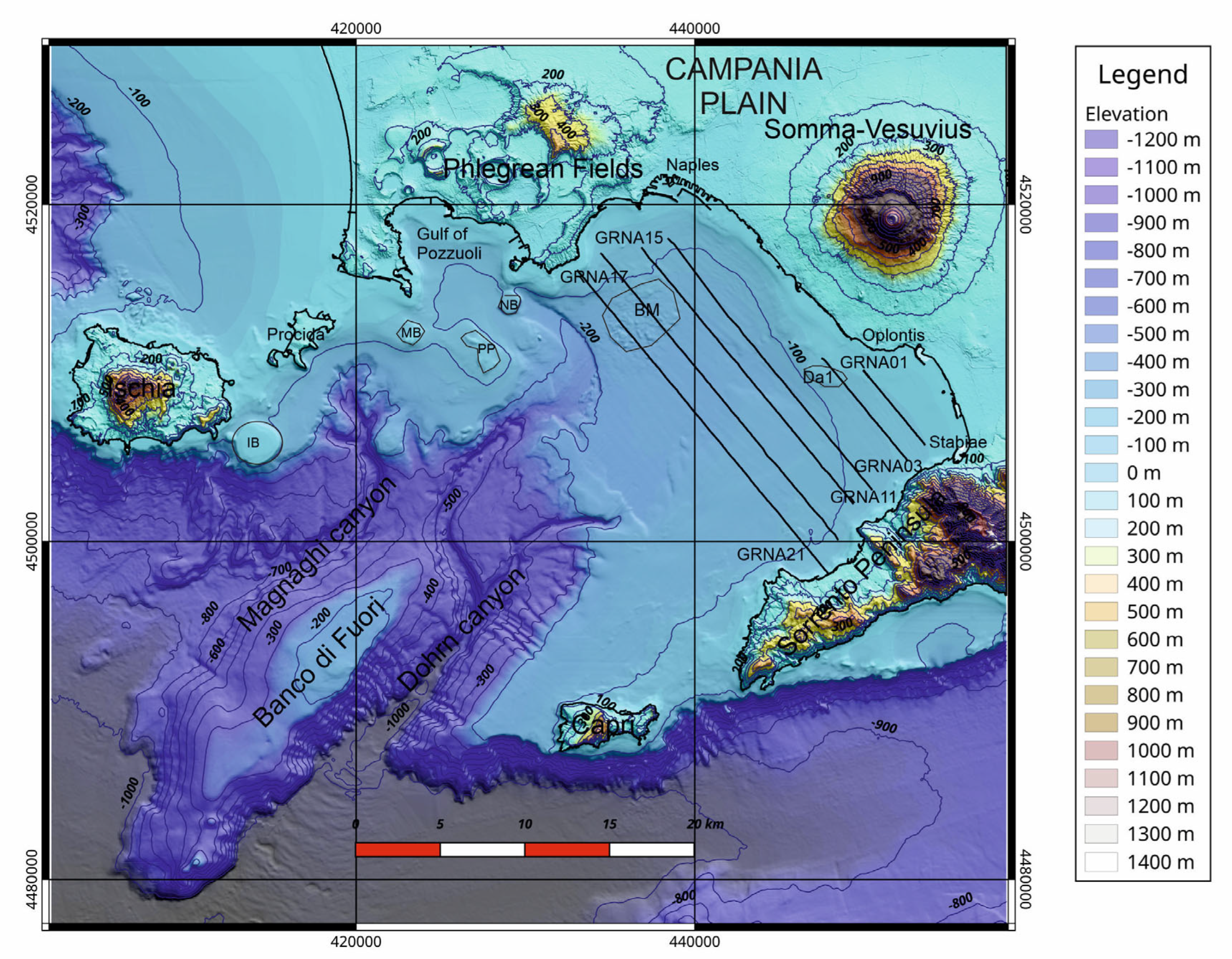
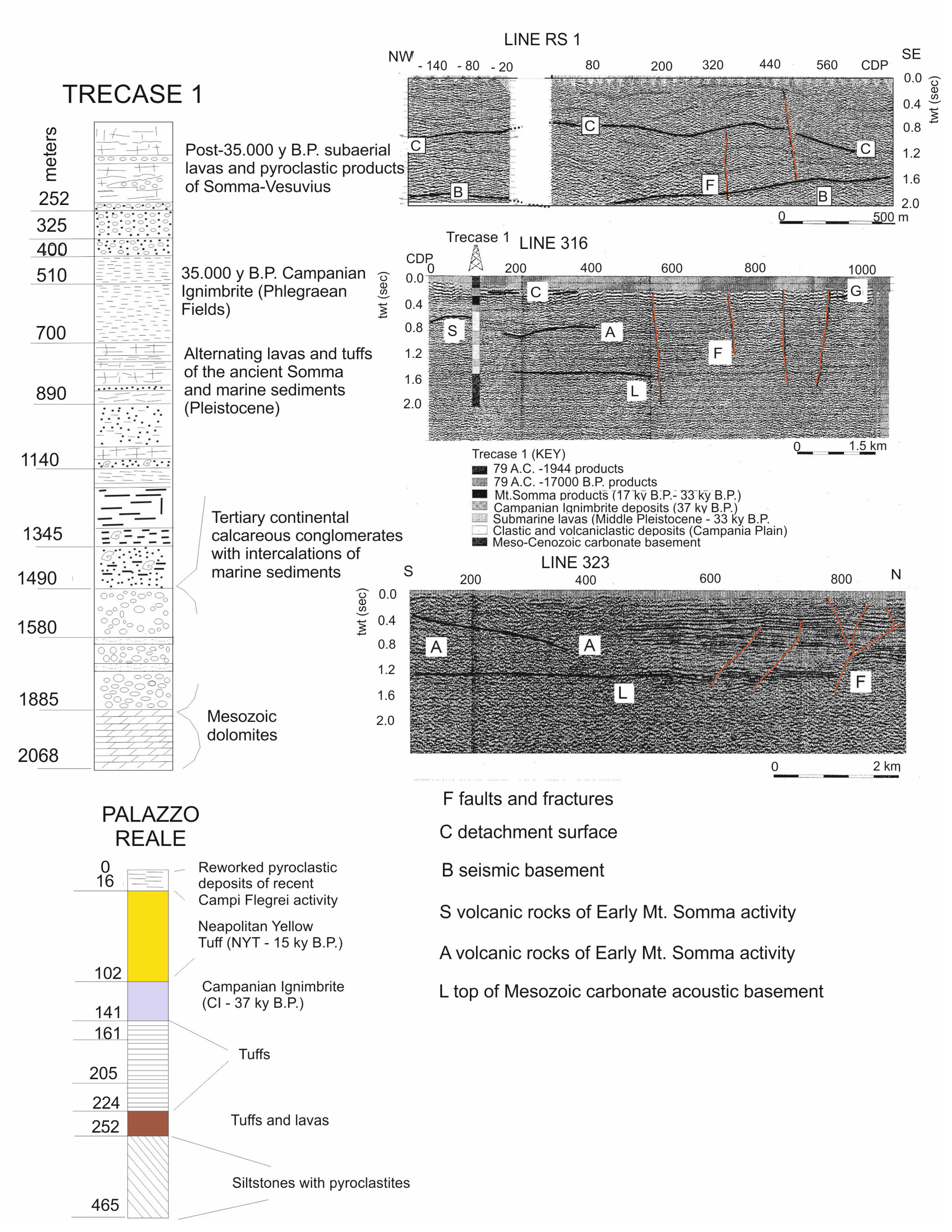
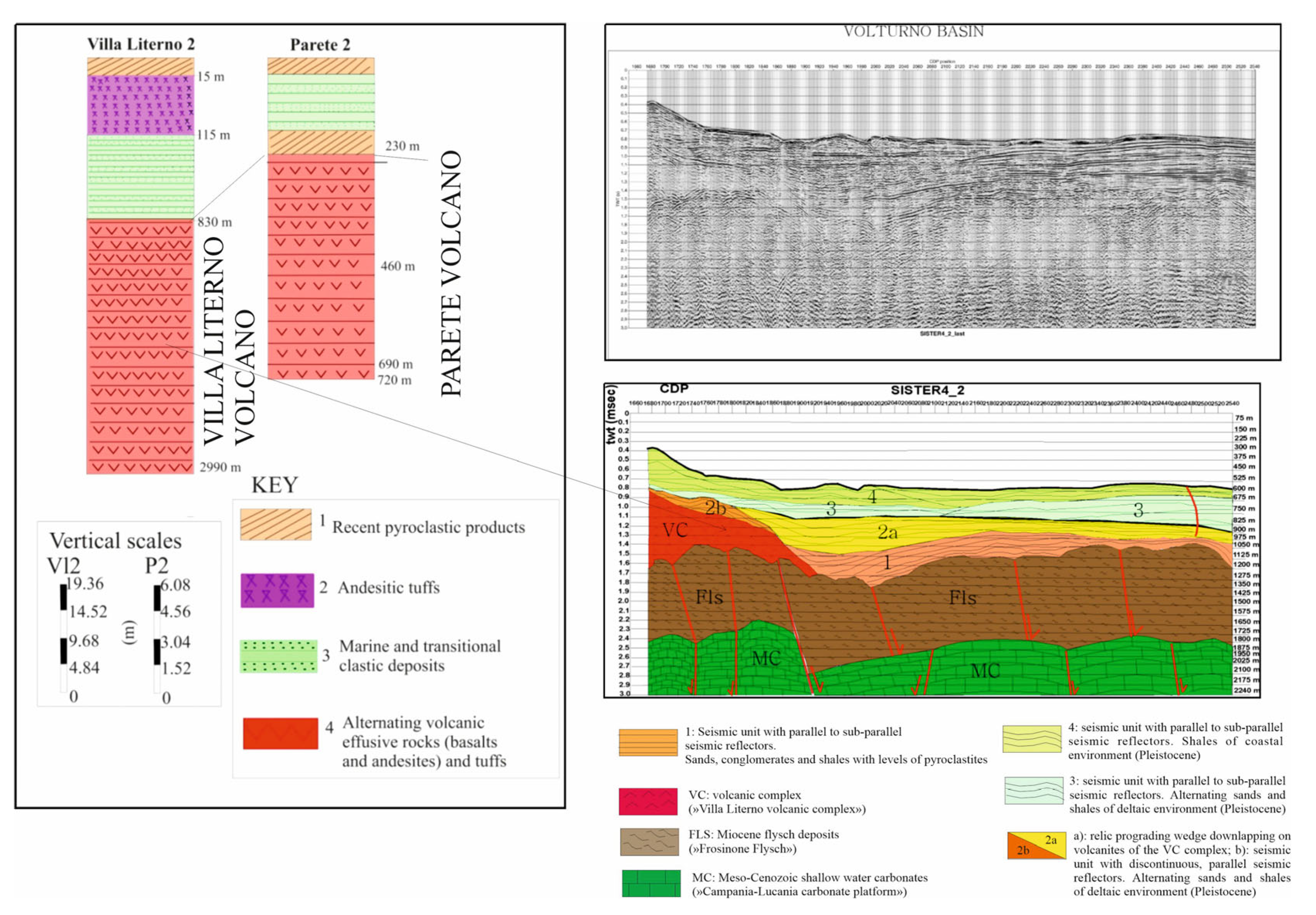
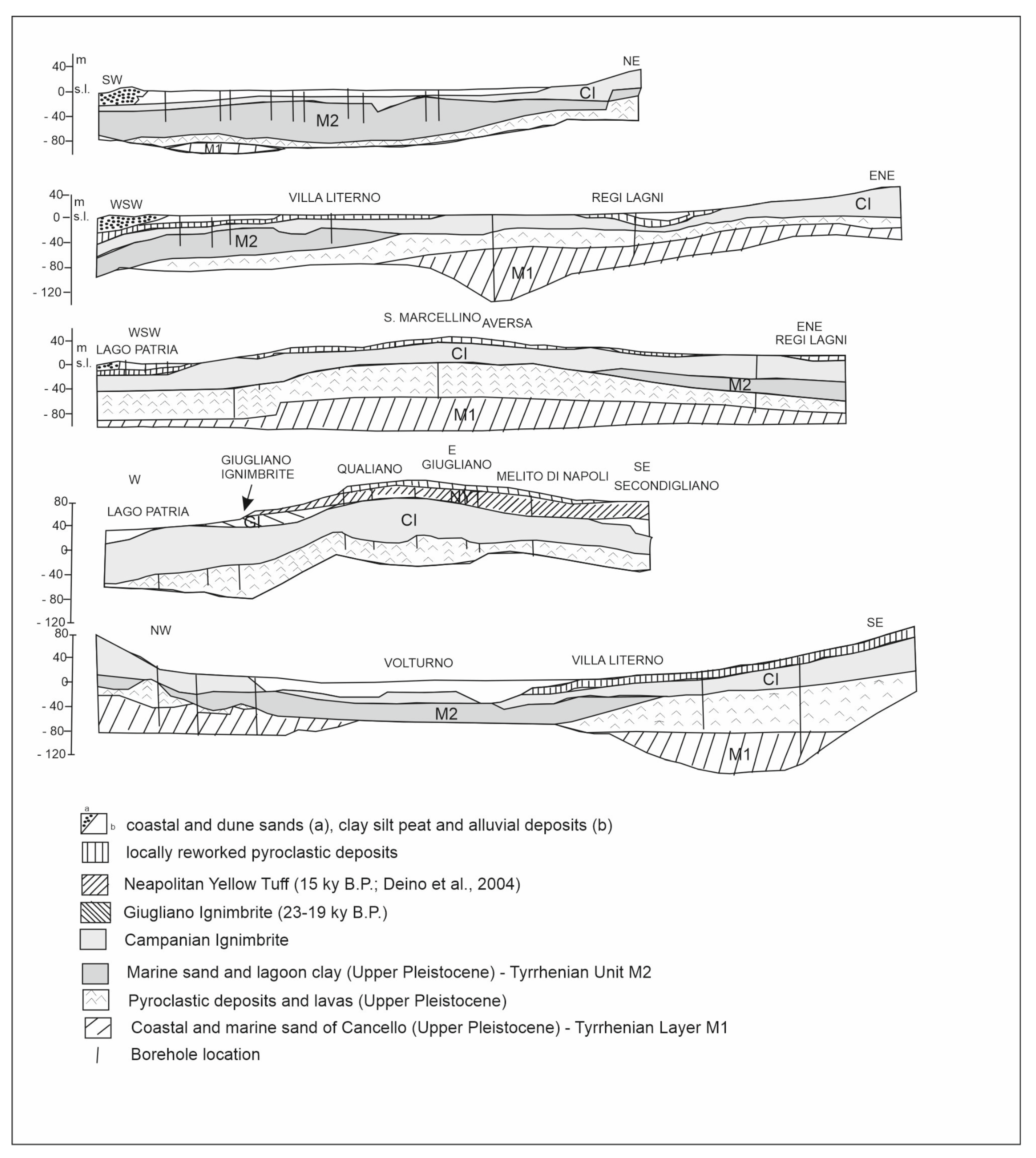
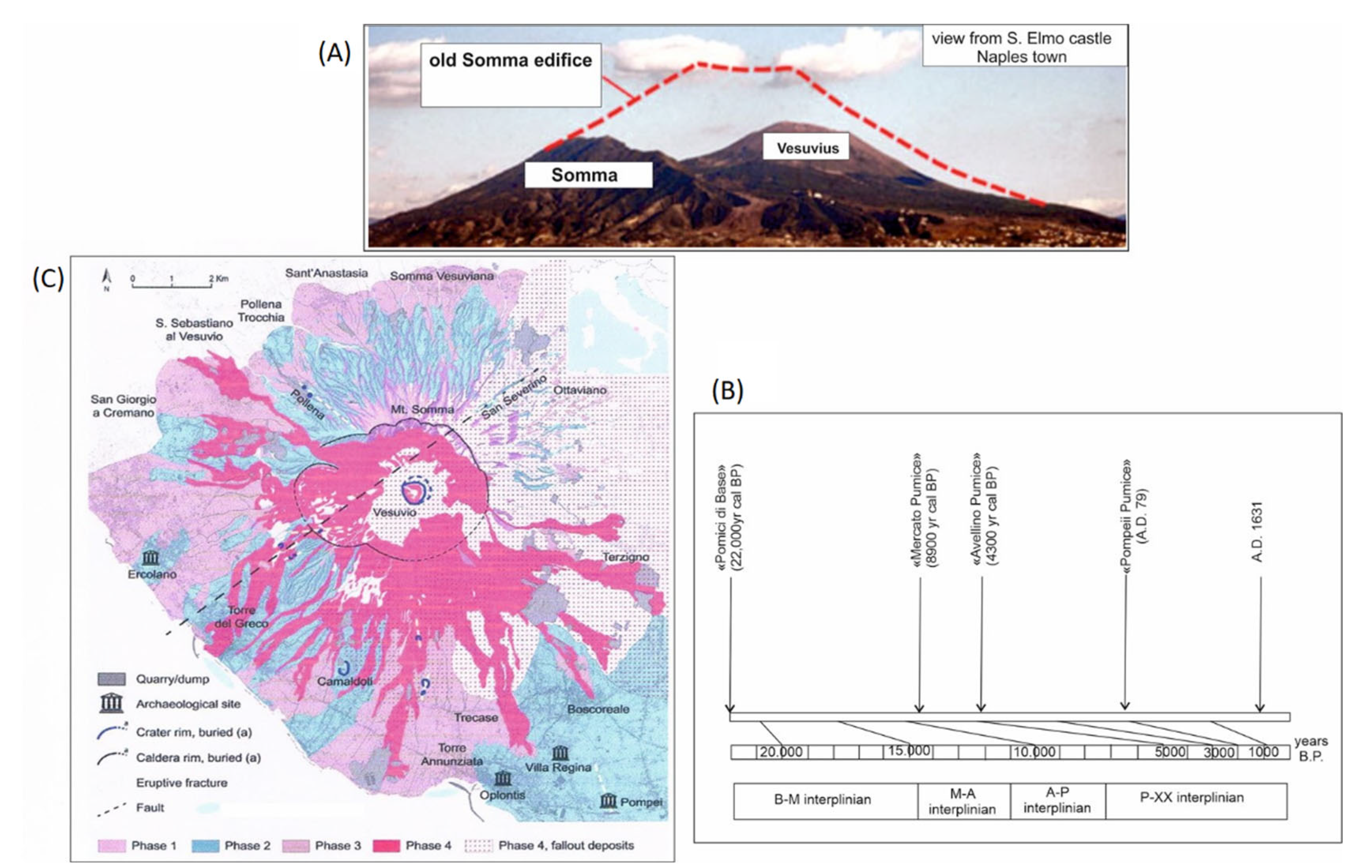
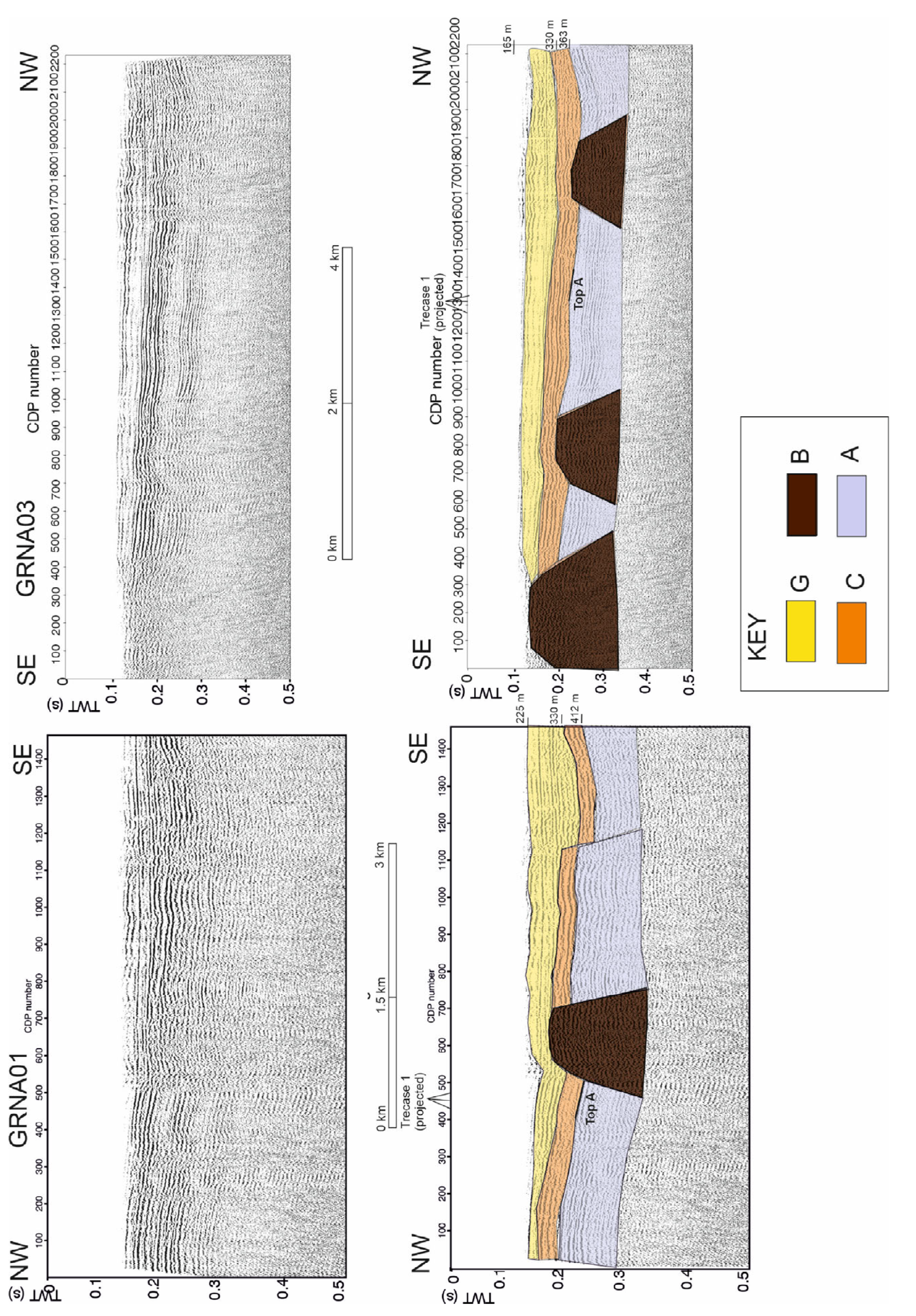
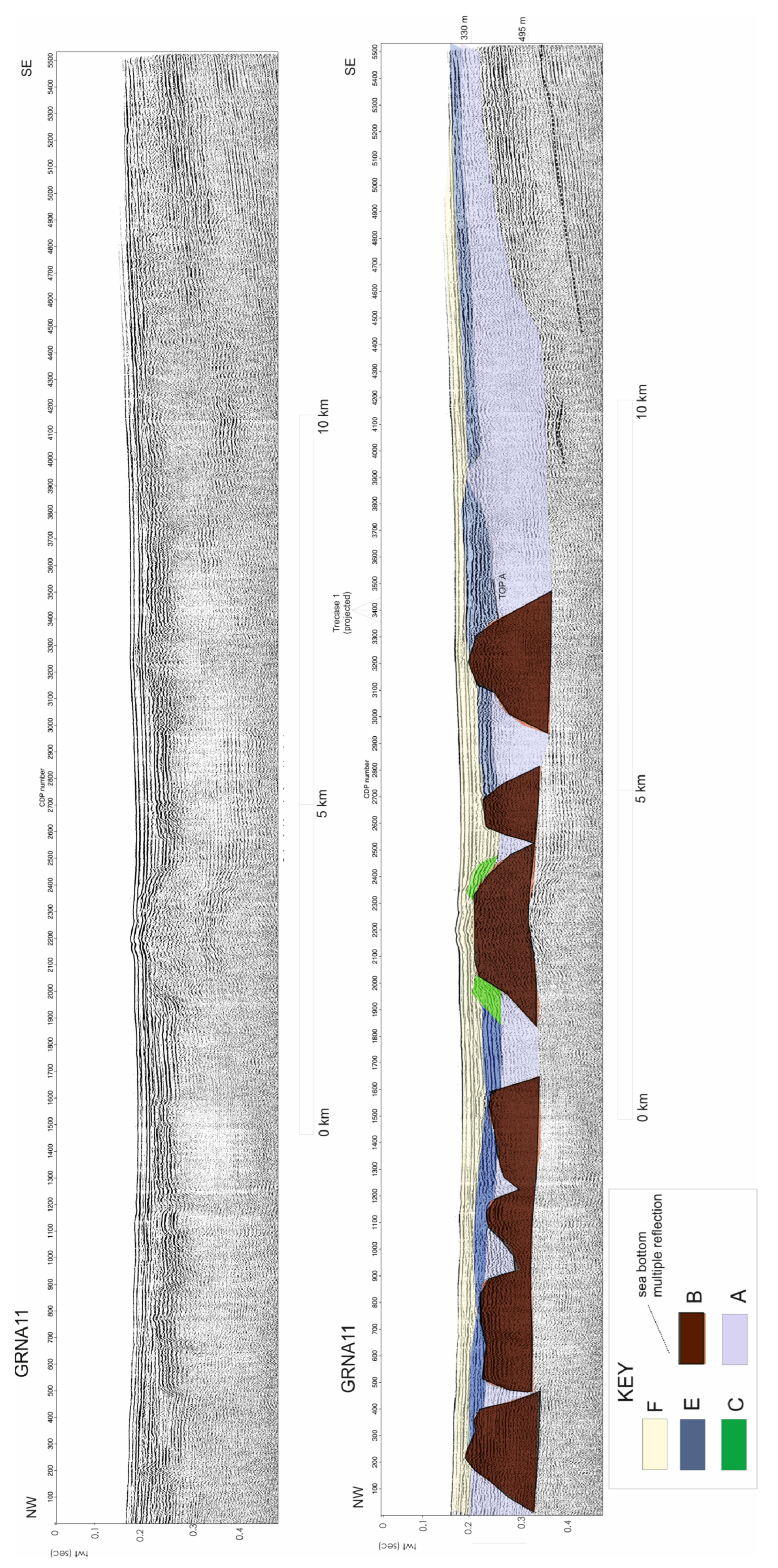
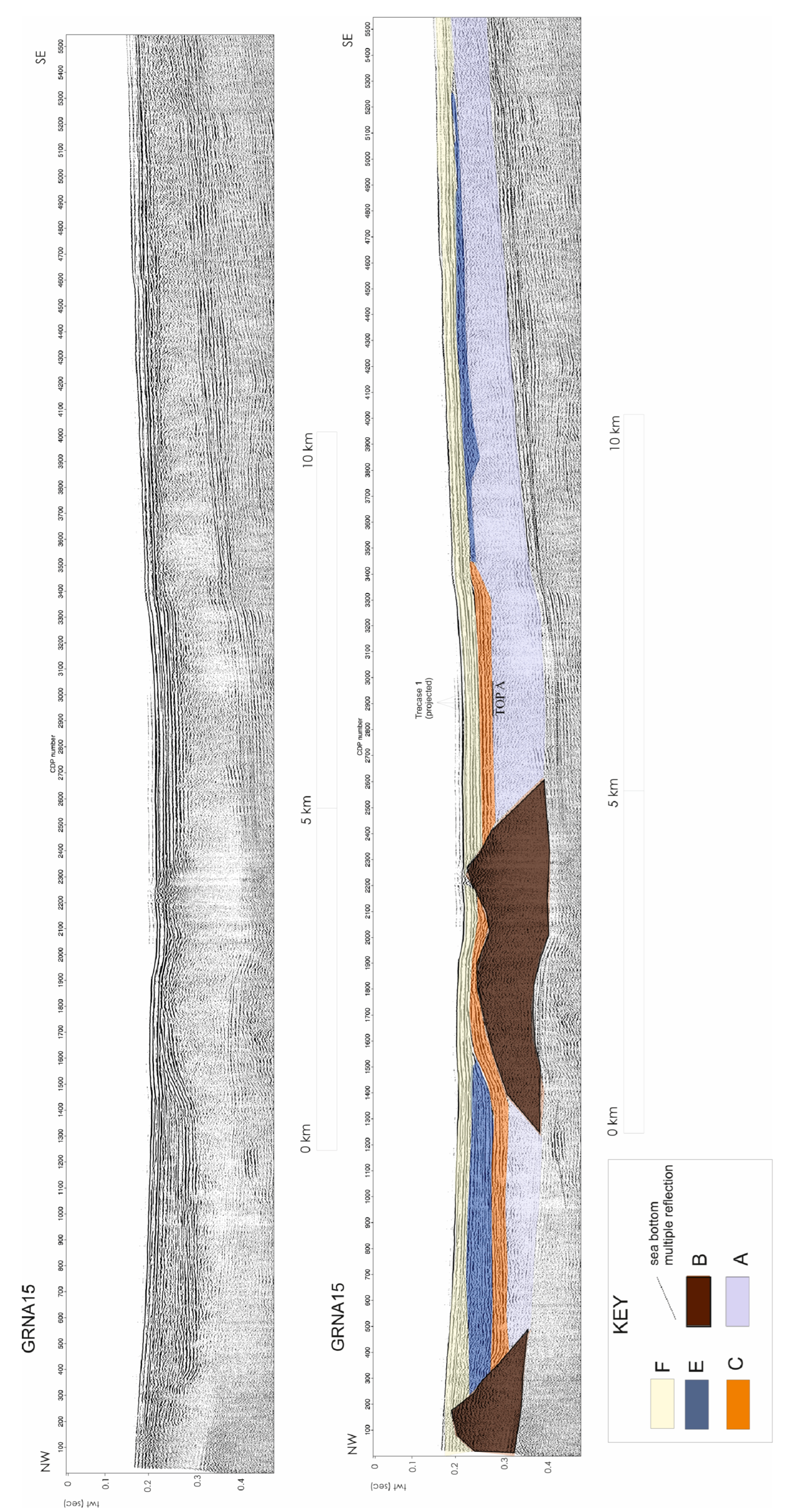

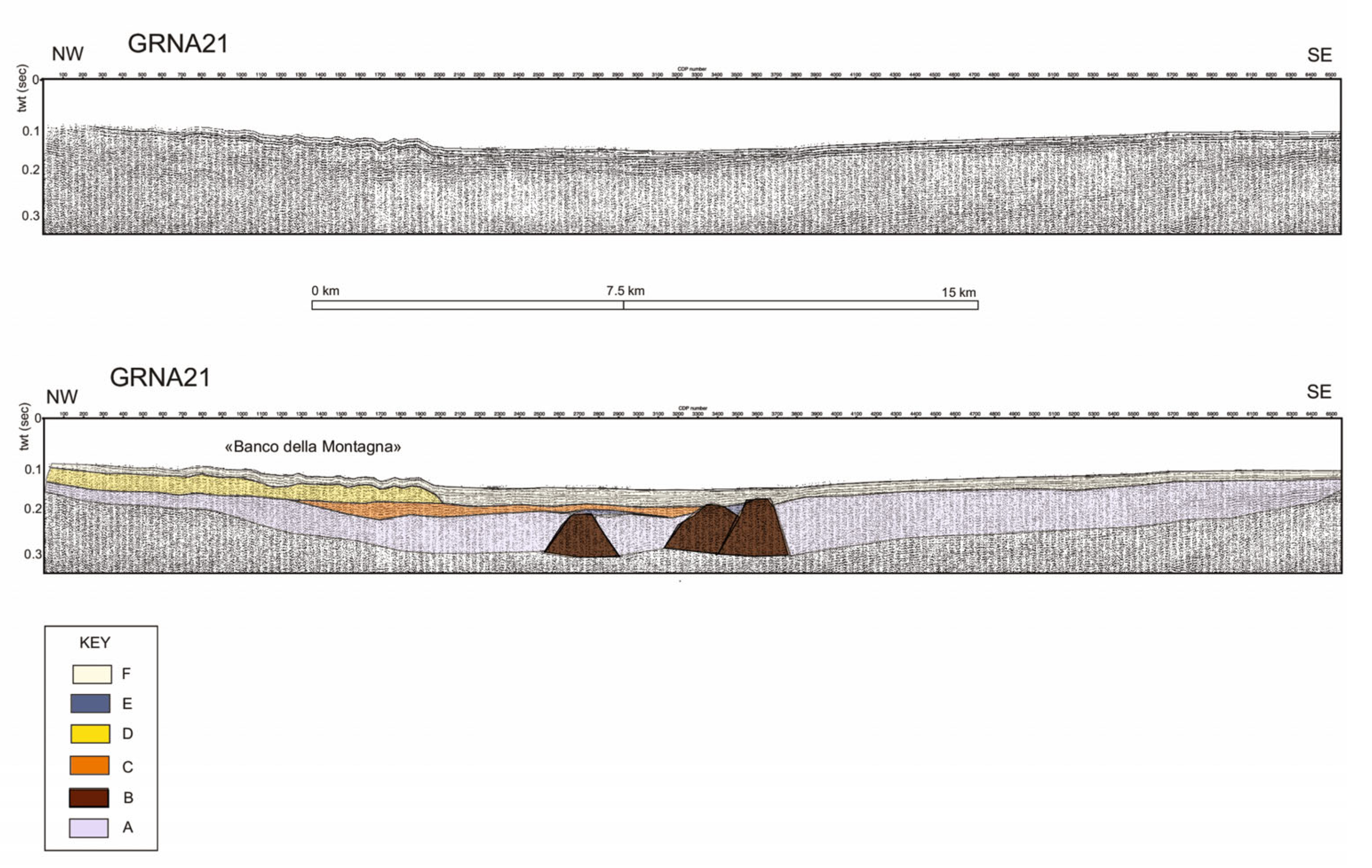
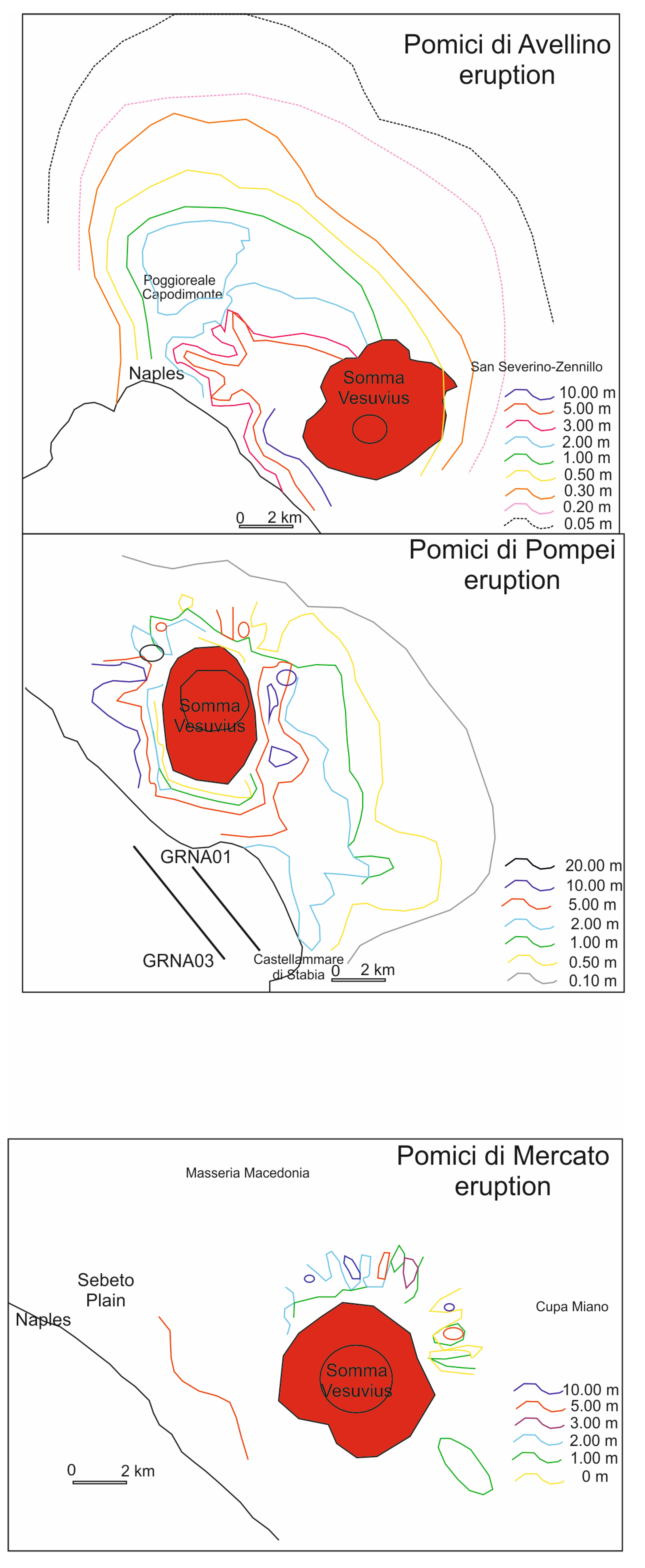
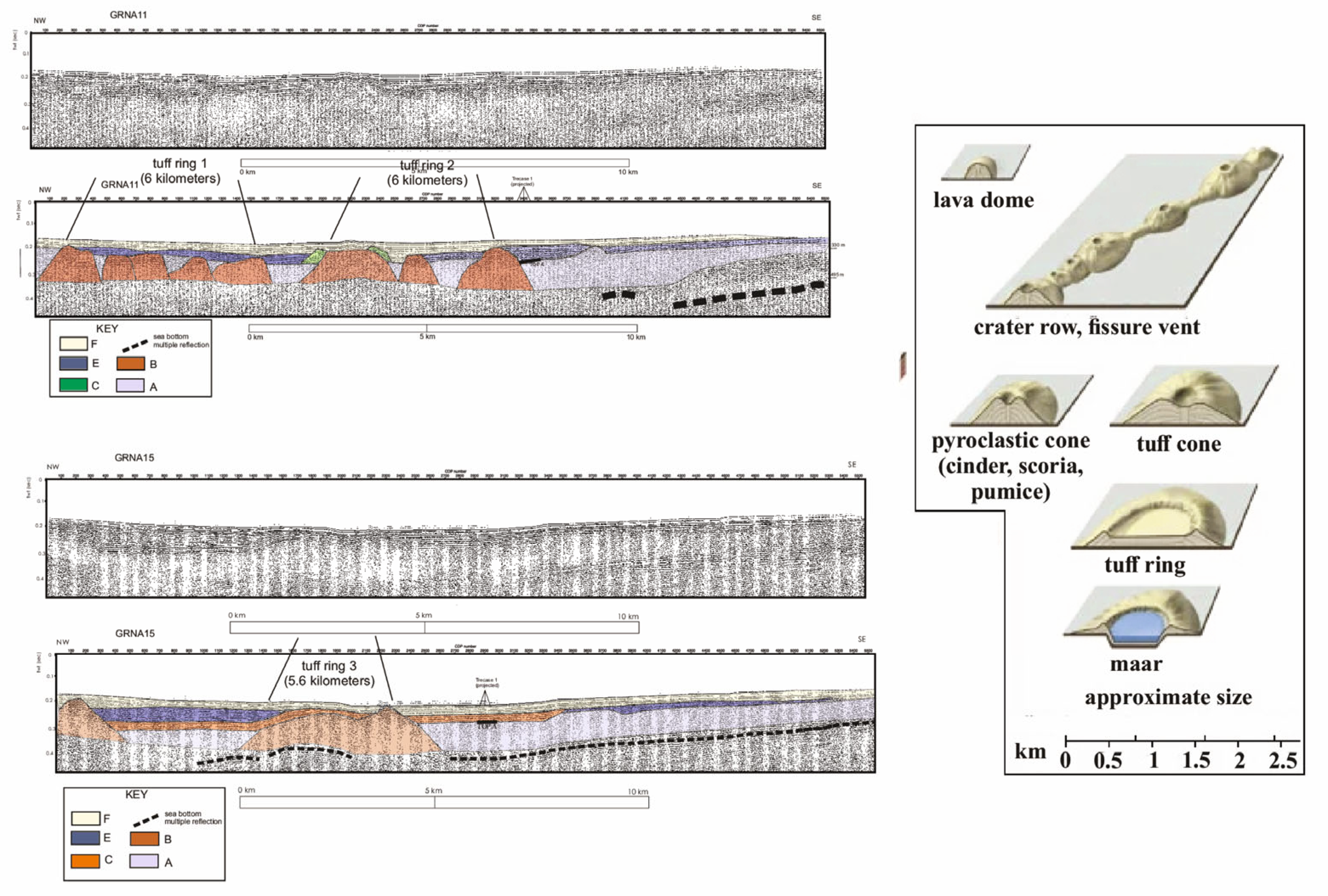
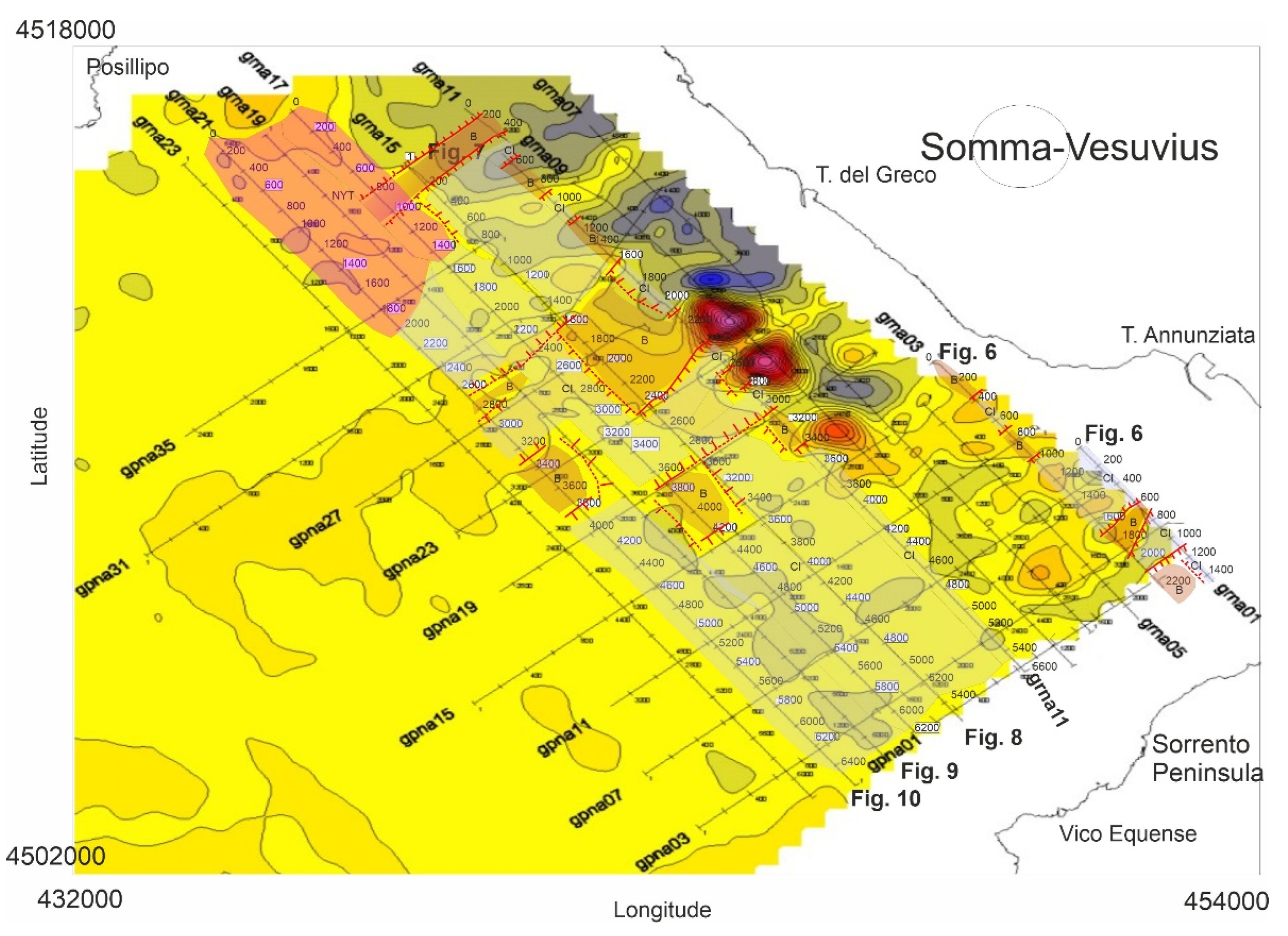
| Seismic Profiles | Seismic Units | Seismic Facies External Geometry |
|---|---|---|
| GRNA01, GRNA03 | G | Undulated and wavy seismic reflectors, discontinuous. |
| GRNA11, GRNA15, GRNA17, GRNA21 | F | Parallel and continuous seismic reflectors and wedge-shaped external geometry |
| GRNA11, GRNA15, GRNA21 | E | Discontinuous and sub-parallel seismic reflectors |
| GRNA17, GRNA21 | D | Acoustically-transparent seismic facies, wedge-shaped unit |
| GRNA01, GRNA03, GRNA11, GRNA17, GRNA21 | C | Parallel and continuous seismic reflectors. Prograding reflectors onlapping the top of a seismic structure composed of the B unit. |
| GRNA01, GRNA03, GRNA11, GRNA15, GRNA17, GRNA21 | B | Acoustically-transparent seismic facies and mounded-shaped external geometry |
| GRNA01, GRNA03, GRNA11, GRNA15, GRNA17, GRNA21 | A | Acoustically transparent seismic facies and tabular external geometry |
Publisher’s Note: MDPI stays neutral with regard to jurisdictional claims in published maps and institutional affiliations. |
© 2022 by the author. Licensee MDPI, Basel, Switzerland. This article is an open access article distributed under the terms and conditions of the Creative Commons Attribution (CC BY) license (https://creativecommons.org/licenses/by/4.0/).
Share and Cite
Aiello, G. Submarine Stratigraphy of the Eastern Bay of Naples: New Seismo-Stratigraphic Data and Implications for the Somma-Vesuvius and Campi Flegrei Volcanic Activity. J. Mar. Sci. Eng. 2022, 10, 1520. https://doi.org/10.3390/jmse10101520
Aiello G. Submarine Stratigraphy of the Eastern Bay of Naples: New Seismo-Stratigraphic Data and Implications for the Somma-Vesuvius and Campi Flegrei Volcanic Activity. Journal of Marine Science and Engineering. 2022; 10(10):1520. https://doi.org/10.3390/jmse10101520
Chicago/Turabian StyleAiello, Gemma. 2022. "Submarine Stratigraphy of the Eastern Bay of Naples: New Seismo-Stratigraphic Data and Implications for the Somma-Vesuvius and Campi Flegrei Volcanic Activity" Journal of Marine Science and Engineering 10, no. 10: 1520. https://doi.org/10.3390/jmse10101520





